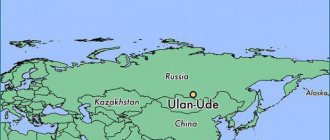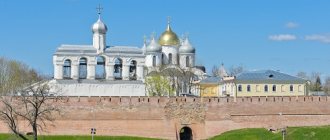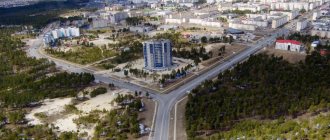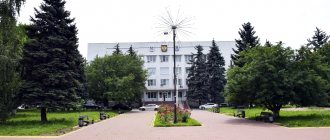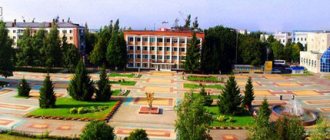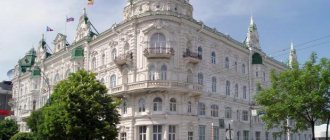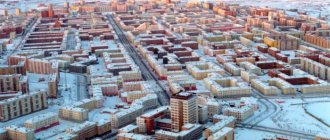Story
The population of Kingisepp has remained stable in recent years. But the first settlement on this site appeared in 1348. Such data is contained in the Novgorod Chronicle. Initially the city was called Yam. With the help of this settlement, the Novgorodians strengthened their borders from attacks by the Germans and Swedes. A stone wall with gates and towers was built here, which withstood the siege of both the Livonian Confederation and the Swedish troops. In the Livonian chronicles you can find a description of this settlement called Nienslot, which means New Town, or New Castle.
In the 15th century, the settlement became not only a military center, but also a trade and craft center in the north-west of Rus'. In 1583, Russia still ceded the current Kingisepp to Sweden; it was returned after 12 years. In 1681, during another armed conflict, walls and towers were blown up. In 1700, Russian troops recaptured the city at the very beginning of the Northern War. Then it goes to Prince Menshikov, and when he is sent into exile, it returns to the treasury.
At the beginning of the 18th century, the glass industry began to develop here, and a textile factory appeared. In 1784, Yamburg officially became a district town. At the beginning of the 19th century, Yamburg turned out to be one of the poorest cities in the St. Petersburg province. The main income can be obtained from renting houses to stationed military personnel. It was the military personnel who made up a significant part of the population of Kingisepp before the revolution. For example, in 1849, of the 2,100 residents, more than 60 percent were military personnel.
Parks and reserves of Kingisepp
For lovers of hiking and nature, the city has parks with amazing landscapes. In the shade of the trees you can relax on a bench by the river or go rollerblading or play sports with the whole family. Residents of Kingisepp love to spend time in local parks, as they are often quiet. However, festivals and festive concerts are often held in green meadows.
Summer Garden Park
An ideal place for both solitary contemplation and family relaxation. The park is located on the shore of a pond. Even on the hottest days, here you can hide from the scorching sun in the shade of the trees and feel the coolness coming from the water. You can often meet fishermen here.
The park area was created by soldiers of the 146th Tsaritsyn Regiment. Nearby is St. Catherine's Cathedral. At the exit from the park, travelers are greeted with an amazing picture - the monumental walls of the ruins of the Yam fortress.
Memorial Park "Grove of Five Hundred"
We are talking about a tribute to the dead soldiers and missing residents of Kingisepp during the Second World War. Here there is a Stella on which the names of the heroes are carved, a mass grave, a monument to the Bolsheviks who were shot.
Visitors to the park can also visit the grave of soldiers of the Estonian Rifle Corps and see the monument to the first fallen soldier from Kingisepp in Afghanistan. Citizens honor this place by paying tribute to the heroes of their city.
The history of the name “Grove of the Five Hundred” is full of cruelty and bloodthirstiness. In 1919, General Yudenich ordered the execution of half a thousand Bolsheviks. The bloody bodies were hanged demonstrably from the trees of this park to intimidate the population.
Romanovka Park
The estate belonged to the hero of the Patriotic War of 1812, a participant in the Battle of Borodino and many other iconic battles of the first half of the 19th century, Karl Ivanovich Bistrom.
Often visiting his relatives in these lands, he fell in love with the landscapes overlooking the river and the monumental walls of the ancient fortress. In the early 30s. they began to belong to his family. Bistrom did not have a chance to take care of his lands for long. A few years later he died and was buried right here in Yamburg. The sculpture “Bronze Lion” was installed on the grave.
In addition to its historical value, this park serves many other functions for the residents of Kingisepp. It regularly hosts concerts and festivals. On weekdays it is quiet and peaceful here. You can enjoy the magnificent scenery near the Luga River.
XX century
During the Civil War, for the city of Kingisepp, Soviet troops fight with the corps of the North-Western Army of the White Guards. In 1919, the Whites occupied Yamburg, but only held it for a few months. The settlement passes over to the Red Army, and when the White Guards recapture it again, the Bolsheviks set fire to the barracks during their retreat, which causes significant damage to all buildings in Yamburg. The Red Army manages to finally occupy it in mid-November.
In May 1922, Yamburg was renamed Kingisepp in honor of the Estonian revolutionary who organized the revolutionary movement in his homeland. In 1918, the revolutionary worked underground in Estonia, leading the Communist Party there, which was banned by the authorities. At the first party congresses he was elected a member of the Politburo, he created underground printing houses and published a local newspaper called “Communist”. In 1922 he was arrested by the police. He was tortured, and then a court-martial was staged, as a result of which Viktor Kingisepp was shot. His corpse was drowned directly in the Baltic Sea.
Excursions
Due to the low popularity of the city among tourists, Kingisepp does not have a wide variety of excursion programs.
Fortresses of the North-West
The excursion program includes visits to the sights of 3 cities that are important for the safety of state borders:
- in Koporye – visit to the 13th century fortress of the same name;
- in Kingisepp - Yam fortress, Catherine's Cathedral;
- in Ivangorod – visit to the fortress of the 15th-16th centuries and the exhibition of the Small Powder Granary.
Duration 10-11 hours. The excursion is carried out in a group of up to 25 people. Ticket price for 1 adult from 1270 rubles.
Kingisepp-Pilovo-Vistino-Luga Bay
The excursion includes transfer from and to St. Petersburg. Duration up to 12 hours.
In Kingisepp you can visit:
- city center with a sightseeing tour;
- St. Catherine's Cathedral;
- Summer Garden;
- local history museum.
In Pillovo - an excursion to the chapel of the Pochaev Mother of God, in Vistino - a visit to the Izhora Museum.
At the end of the tour:
- walk in the Kurgalsky reserve;
- trip to the chapel of St. Nicholas the Wonderworker;
- walking along the Gulf of Finland.
Excursions to the Kingisepp Museum of History and Local Lore
You can order a tour from the museum staff. The table shows the main list of services. The duration of all programs is from 45 minutes to 1 hour.
| Excursion type | Price |
| city tour | 1000 rub./1 person |
| dedicated to a temporary exhibition | 210 RUR/up to 7 people + entrance fee |
| ancient settlement of Yam fortress | 50 rub./1 person |
| virtual fortress Yam | 350 RUR/up to 7 people + ticket price |
| making folk dolls, weaving | 50 rub./1 person + purchase of material (up to 150 rub.) |
| interactive quest “The Secret of the Old Fortress of Yam-Yamburg” | 50 rub./1 person (pre-registration required, only available in summer) |
During the war
During the Great Patriotic War, the city of Kingisepp was occupied already in August 1941 by the North Army Group. Throughout the war against the Nazis, partisan detachments were active in the surrounding areas and carried out sabotage activities. Partisan detachments concentrated in the vicinity of this city regularly inflicted significant damage on German troops, helping the Red Army fight against the Nazi invaders.
Kingisepp was liberated only in February 1944. The city became free as a result of the large-scale Leningrad-Novgorod operation, which helped liberate Leningrad after a long siege, which became one of the most striking examples of people's courage and perseverance during the war.
In 1963, industry began to actively develop in the city, a mining and processing plant called “Phosphorite” appeared, which began mass production of phosphate rock. Over time, it becomes a city-forming enterprise for the city. In 1984, the city was awarded the Order of the Patriotic War, 1st degree, for the steadfastness and courage shown during the years of confrontation.
In the history of modern Russia, the borders of Kingisepp expanded due to the annexation of the villages of Kaskolovka and Lesobirzha, as well as the village of Novy Lutsk, to it in 2001.
Route for exploring the city on your own in 1-2 days
Kingisepp, whose attractions, despite their small number, play an important role in studying the history and culture of the country, can be explored in 1-2 days.
On day 1, you can explore memorable places on the right bank of the Luga River along the following route:
- St. Catherine's Cathedral (Voskov St., 27B/6);
- monument to partisan heroes (Karl Marx Ave.; 150 m);
- Kingisepp Museum of History and Local Lore (Karl Marx Ave. 1; 100 m);
- Summer Park (Zhukov St.; 350 m);
- monument “Cranes” (280 m; Oktyabrskaya street);
- monument to Crow and Fox (500 m; Oktyabrskaya street).
Kingisepp.
Sights: worth a look at the monument to the Crow and the Fox. You can start day 2 by getting to know the important places on the left bank:
- Grove of Memory (Narvskoye Highway);
- Romanovka Park (200 m);
- monument to K.I. Bistroma (Komsomolovka St.; 280 m);
- in the remaining time you can visit the “Ski Base” and “Equestrian Club”.
Population dynamics
The first official data on the population of Kingisepp dates back to 1856. At this time, a little more than two thousand people live here. In 1885, the population of Kingisepp exceeded three thousand inhabitants, by the end of the century it increased to 4.5 thousand, but during revolutions and the Civil War it decreased. In 1920, just over three thousand people remained here.
The city experienced its next significant decline in population after the Great Patriotic War. If in 1939 almost 8 thousand people lived here, then by 1945 a little more than 2.5 thousand remained.
With the development of industry, the city is growing, not only houses and factories are being built, but also residential buildings for workers. In 1970, there were more than 17 thousand inhabitants, and by 1979 - almost 39 thousand.
The population of Kingisepp continues to grow at a rapid pace, reaching 50 thousand people in 1990. During the 90s, no significant decline was observed. But due to the fact that young people tend to leave for larger and more successful cities, primarily St. Petersburg, the population has been constantly falling since 2000. True, at a slow pace. Currently, 46,747 people live in the city.
The population density of Kingisepp is just over a thousand people per square kilometer.
How to get there
Transport links with neighboring cities are quite developed. The Moscow-St. Petersburg-Estonia railway and the St. Petersburg-Tallinn highway pass through Kingisepp.
By plane
The nearest city where the airport is located is St. Petersburg (130 km from Kingisepp). The cost of a plane ticket Moscow-St. Petersburg-Moscow is from 4,400 rubles/1 adult economy.
From Bus Station No. 2 of St. Petersburg to Kingisepp there are buses 841 (the final one is the old Kingisepp station) and 851 (to the city of Slantsy with a stop in Kingisepp). The fare starts from 300 rubles/1 person. Travel time is from 2 to 3 hours.
By train
The Moscow-Tallinn Baltic Express train stops in St. Petersburg and Kingisepp.
Travel time Moscow-Kingisepp - 10 hours 47 minutes, tickets cost from 1182 rubles; St. Petersburg-Kingisepp – 2 hours 37 minutes, from 552 rubles. Electric train 6661 departs from the Baltic Station in St. Petersburg at 18.05 (time may change), heading to Ivangorod via Kingisepp. Ticket prices start from 335 rubles.
By car
By car you can get to Kingisepp along the federal highway A-180 (Narva).
Unemployment rate
At the moment, the unemployment rate in Kingisepp remains one of the lowest in the Leningrad region. It is only 0.4%. As officials note, some credit for this goes to the Kingisepp employment center. Anyone can find a job here. The center itself is located at 6B Vostochnaya Street.
There are a large number of programs in the field of social protection of the population. Kingisepp has a very high average salary. In addition, over the past year it has grown by more than 14 percent and now equals 52,244 rubles.
Where to go with children in Kingisepp
There are theaters and entertainment centers for the youngest guests in Kingisepp. Their main goal is not only to provide leisure time for children, but also to instill in them a love of art and active recreation.
Theater of the Young Spectator named after. Yu.Ya. Shishkina
- Address: Karl Marx, 40.
Since 2001, a Youth Theater was opened on the site of the old city cultural center. During its existence, about 20 productions can be distinguished, which are regularly included in the theater’s repertoire. Young viewers can immerse themselves in the world of a fairy tale by visiting this place. There are also performances with puppets that fascinate the smallest children. The theater employs talented actors, directors, decorators, costume designers, and composers to introduce children to art and instill a love for it from an early age.
Family entertaining
- Address – Bolshaya Grazhdanskaya, 2g.
There is everything you need for a relaxing holiday for parents and their children. Entertainment shows, trampolines, gaming machines, air hockey and much more - all in one entertainment center. After active games, you can relax in the food court, where a variety of food and drinks are offered.
City House of Culture
- Address: Karl Marx, 40.
The program of the Kingisepp Palace of Culture regularly includes performances and events for the whole family. Famous artists (trainers, comedians, actors) often come here on tour.
Ice Arena "Olympus"
- Address: Shadrina, 16.
Both adults and children will enjoy skating on the modern ice arena. Entertainment events with competitions and prizes are regularly held here. The skating rink is available for visiting not only during the day, but also at night. Public night skiing is extremely popular among visitors to this winter attraction.
Don't miss the sights of other cities in the Leningrad region:
- St. Petersburg, Ivangorod, Primorsk, Kronstadt and Gatchina,
- Tsarskoye Selo, Novaya Ladoga, Luga, Tosno, Sosnovy Bor,
- Strelna, Shlisselburg, Sestroretsk and Vyborg, Krasnoye Selo,
- Lodeynoye Pole, Vyritsa, Vsevolozhsk, Lomonosov and Tikhvin.
It will take more than one day to explore all the sights of Kingisepp. In addition to ancient architectural monuments and spiritual places, the whole family can visit entertainment centers, bowling alleys, and a cinema. Special attention should be paid to the cafes and restaurants of Kingisepp. The establishments offer dishes of Russian, European and Oriental cuisine. The interior designs are amazing - from classic loft to Scandinavian style.
Climate
The city is located in the southwestern part of the Leningrad region, directly on the Luga River. It is relatively close to St. Petersburg - about 130 kilometers. Therefore, a considerable part of the residents of Kingisepp manage to find work in the Northern capital and cover this two-way distance every day.
The climate is quite moderate, the average annual temperature is about 5.5 degrees. The wind speed is low - on average about 2-2.5 meters per second. The absolute maximum is observed in August, when the air warms up to plus 35 degrees, and the absolute minimum temperature is recorded in January and December, when it reaches minus 40. At the same time, the average temperature in summer is 16-18 degrees, and in winter - minus 5-6.
Ecology
60% of the Kingisepp district is occupied by forests, 12% by swamps. The ecological situation in this area is favorable. The content of harmful substances in the soil and air does not exceed the norm.
The EuroChem enterprise, which produces agricultural fertilizers, is located in the Kingisepp district. When taking water samples in the immediate vicinity of the plant, elevated levels of phosphorus and copper were detected.
Urban architecture
The fortress of the second half of the 18th century is of particular architectural value in Kingisepp. True, very little remains of it; only the remains of several walls and high ramparts have survived.
According to a plan developed back in the 18th century, or, to be precise, in the 1780s, the city received a regular layout. Two buildings have survived to this day in the octagon-shaped shopping area. The creation of its project is attributed to the famous Italian architect, Antonio Rinaldi, who worked in Russia for a long time. These buildings were built in 1835. The arena building, created in 1836, is also of interest.
The main religious building of the city is the five-domed Catherine Cathedral, which it was decided to build after the wooden fortress Cathedral of St. Michael the Archangel burned down in 1760. The construction of a new Orthodox church began by decree of Empress Elizabeth on the central square of Yamburg in the very center of the city. The initial project was created by Bartolomeo Rastrelli, and it was finalized and implemented by Rinaldi. The cathedral was built in a transitional style; here you can find elements of Baroque and Classicism, which is typical for the projects of these architects.
The plan of the cathedral is interesting, which is an equilateral cross, the ends of which are rounded; the temple is crowned by a bell tower, built on several tiers. At the same time, the toponymy of the city still has a Soviet character. Not long ago, residents were offered to rename the city from Kingisepp back to Yamburg, but the majority reacted negatively to this proposal.
Leisure
Kingisepp is suitable for lovers of active recreation. After sightseeing, you can go to the Kopanskoye recreation center (90 km from the city). Buses 75/83, 85/83, 56/60 go to your destination from the city station. There are 6 cottages on the territory, accommodating from 4 to 8 people (from 5 thousand rubles/day). It is possible to order a bathhouse (3000 rubles/2 hours).
Guests can use the equipped sandy beach and take a boat ride on the lake (from 200 rubles/1 hour). The place is suitable for fishing, hunting under water and on the shore (for a fee). There is an outdoor play area for children.
The PAZh equestrian club in Romanovka Park offers not only horseback riding (from 150 rubles/1 hour), but also physical education and health services (hippotherapy - from 450 rubles/1 hour), horseback riding with a photo session (1500 rubles/ 40 min, client's camera). Classes are available for children and adults.
